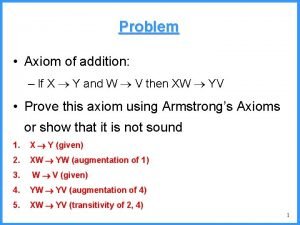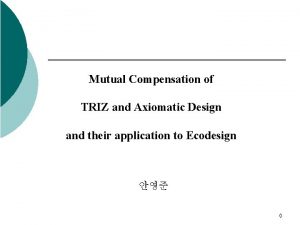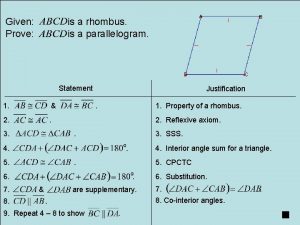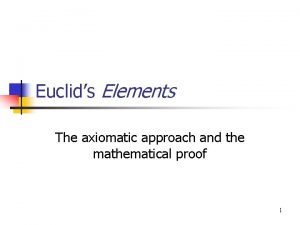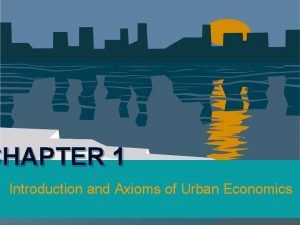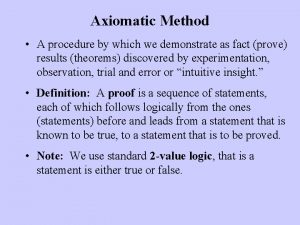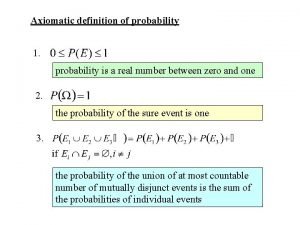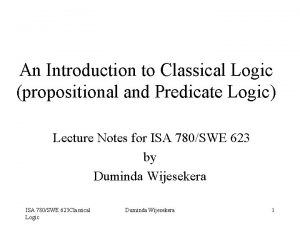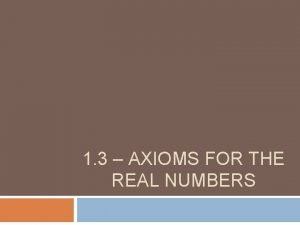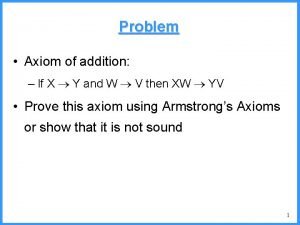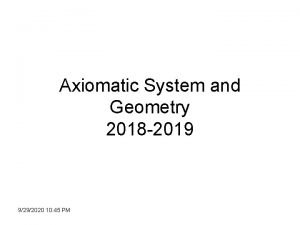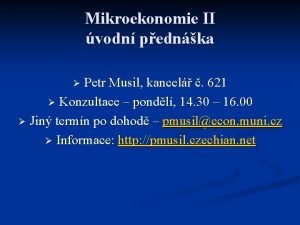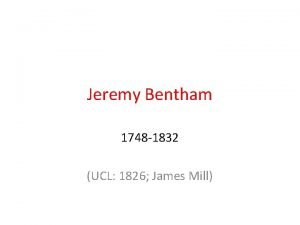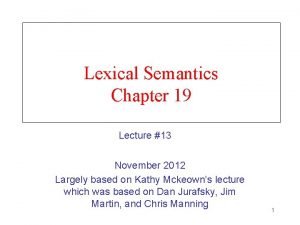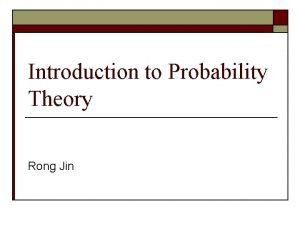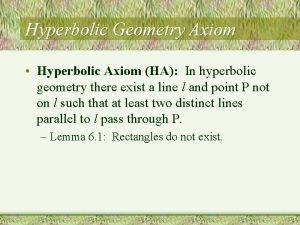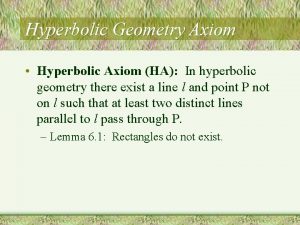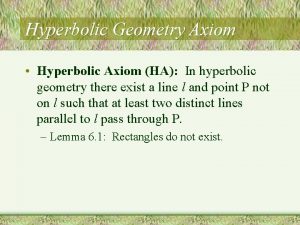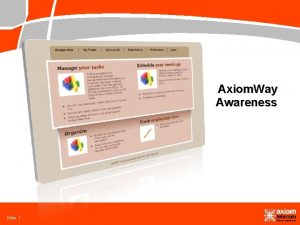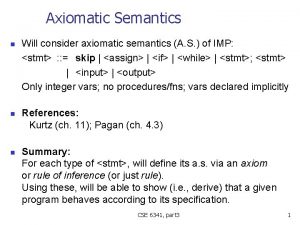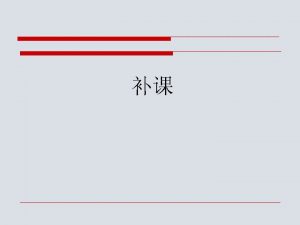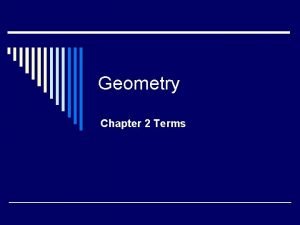Axiomatic Systems Also called Axiom Systems Friday 8




















- Slides: 20

Axiomatic Systems Also called Axiom Systems Friday 8 Sept 2006 Math 362 1

Axiom System An axiom system includes: • Undefined terms • Axioms , or statements about those terms, taken to be true without proof. • Theorems, or statements proved from the axioms (and previously proved theorems) A model for an axiom system is a mathematical system in which: • every undefined term has a specific meaning in that system, and • all the axioms are true. Friday 8 Sept 2006 Math 362 2

Example 1 Axiom System: • Undefined terms: member, committee, on. • Axiom 1: Every committee has exactly two members on it. • Axiom 2: Every member is on at least two committees. Model: • Members: Joan, Anne, Blair • Committees: {Joan, Anne}, {Joan, Blair}, {Anne, Blair} • On: Belonging to the set. Friday 8 Sept 2006 Math 362 3

Example 2 Axiom System: • Undefined terms: member, committee, on. • Axiom 1: Every committee has exactly two members on it. • Axiom 2: Every member is on at least two committees. Model: • Members: Joan, Anne, Blair, Lacey • Committees: {Joan, Anne}, {Joan, Blair}, {Joan, Lacey}, {Anne, Blair}, {Anne, Lacey}, {Blair, Lacey} • On: Belonging to the set. Friday 8 Sept 2006 Math 362 4

Some facts about statements, axioms, and models: • Every theorem of an axiom system is true in any model of the axiom system. • A statement P is said to be independent (or undecidable) of an axiom system if it cannot be proved or disproved within the system. We can show a statement P is independent in an axiom system by showing there is a model of the system in which P is false (so P can’t be a theorem), and also a model of the axioms in which P is true (so the negation of P can’t be a theorem either). Friday 8 Sept 2006 Math 362 5

Example Axioms: 1. There exist exactly six points. 2. Each line is a set of exactly two points. 3. Each point lies on at least three lines. Statement 1: Each point lies on exactly three lines. Statement 2: There is a point which lies on more than three lines. Possible Alternatives to Axiom 3: • 3'. Each point lies on exactly three lines. • 3''. Five of the six points lie on exactly three lines, and the sixth lies on more than three lines. • 3'''. Each point lies on exactly four lines. Friday 8 Sept 2006 Math 362 6

Some facts about statements, axioms, and models: Axiom systems ought to be: • Consistent, that is, free from contradictions. This is true provided there is a model for the system. If so, we know we cannot prove a contradiction through logical reasoning from the axioms. • Independent, so that every axiom is independent of the others. Thus, each axiom is essential and cannot be proved from the others. This can be demonstrated using a series of models. Friday 8 Sept 2006 Math 362 7

Some facts about statements, axioms, and models: In addition, axiom systems can be: • Complete, so that any additional statement appended as an axiom to the system is either redundant (already provable from the axioms) or inconsistent (so its negation is provable). • Categorical, so that all models for the system are isomorphic, i. e. , exactly the same except for renaming. Friday 8 Sept 2006 Math 362 8

By the way. . One of the great results of modern mathematical logic is that any consistent mathematical system rich enough to develop regular old arithmetic will have undecidable statements. Thus, no such axiom system can be complete. This was proved by Kurt Gödel in 1931. This demonstrates an inherent limitation of mathematical axiom systems; there is no set of axioms from which everything can be deduced. There a number of philosophical debates surrounding this issue. Friday 8 Sept 2006 Math 362 9

What does this have to do with us? • In our work in geometry, we will establish an axiom system a little at a time. Occasionally, we will stop to consider whether the axiom we are about to add is in fact independent of the axioms we have established so far. Thus, we will have to have some facility in creating models. Friday 8 Sept 2006 Math 362 10

Incidence Geometry And some models Friday 8 Sept 2006 Math 362 11

Incidence Geometry • • Undefined terms: point, line, lie on. Axioms: 1. For every pair of distinct points P and Q there exists exactly one line l such that both P and Q lie on l. 2. For every line l there exist two distinct points P and Q such that both P and Q lie on l. 3. There exist three points that do not all lie on any one line. Friday 8 Sept 2006 Math 362 12

Some terminology • Definition: Three points P, Q, and R are said to be collinear provided there is one line l such that P, Q, and R all lie on l. The points are noncollinear provided no such line exists. • (Axiom 3 can now be stated as: “There exist three noncollinear points. ”) Friday 8 Sept 2006 Math 362 13

Example Three point plane: • Points: Symbols A, B, and C. • Lines: Pairs of points; {A, B}, {B, C}, {A, C} • Lie on: “is an element of” Friday 8 Sept 2006 Math 362 14

Example -- NOT Three point line: • Points: Symbols A, B, and C. • Lines: The set of all points: {A, B, C} • Lie on: “is an element of” Friday 8 Sept 2006 Math 362 15

Example Four-point geometry • Points: Symbols A, B, C and D. • Lines: Pairs of points: {A, B}, {A, C}, {A, D}, {B, C}, {B, D}, {C, D} • Lie on: “is an element of” Friday 8 Sept 2006 Math 362 16

Example Fano’s Geometry • Points: Symbols A, B, C, D, E, F, and G. • Lines: Any of the following: {A, B, C}, {C, D, E}, {E, F, A}, {A, G, D}, {C, G, F}, {E, G, B}, {B, D, F} • Lie on: “is an element of” Friday 8 Sept 2006 Math 362 17

Example Cartesian Plane • Points: All ordered pairs (x, y) of real numbers • Lines: Nonempty sets of all points satisfying the equation ax + by + c = 0 for real numbers a, b, c, with not both a and b zero. • Lie on: A point lies on a line if the point makes the equation of the line true. Friday 8 Sept 2006 Math 362 18

Example - NOT Spherical Geometry: • Points: {(x, y, z)| x 2 + y 2 + z 2 = 1} (In other words, points in the geometry are any regular Cartesian points on the sphere of radius 1 centered at the origin. ) • Lines: Points simultaneously satisfying the equation above and the equation of a plane passing through the origin; in other words, the intersections of any plane containing the origin with the unit sphere. Lines in this model are the “great circles” on the sphere. Great circles, like lines of longitude on the earth, always have their center at the center of the sphere. • Lie on: A point lies on a line if it satisfies the equation of the plane that forms the line. Friday 8 Sept 2006 Math 362 19

Example The Klein Disk • Points are all ordered pairs of real numbers which lie strictly inside the unit circle: {(x, y)| x 2 + y 2 < 1}. • Lines are nonempty sets of all points satisfying the equation ax + by + c = 0 for real numbers a, b, c, with not both a and b zero. • Lies on: Like the previous models; points satisfy the equation of the line. • Thus, the model is the interior of the unit circle, and lines are whatever is left of regular lines when they intersect that interior. Friday 8 Sept 2006 Math 362 20
 Axiomatic design example
Axiomatic design example Systematic oo
Systematic oo Axiom meaning in maths
Axiom meaning in maths Subtraction axiom
Subtraction axiom Axiomatic design
Axiomatic design Reflexive axiom
Reflexive axiom The axiomatic method
The axiomatic method Self-reinforcing effects generate extreme outcomes
Self-reinforcing effects generate extreme outcomes Definition in an axiomatic system
Definition in an axiomatic system Axiomatic definition of probability
Axiomatic definition of probability Reflexive axiom
Reflexive axiom Reflexive axiom
Reflexive axiom Axiom of addition
Axiom of addition Axiomatic system of geometry
Axiomatic system of geometry Axiom browser automation
Axiom browser automation Kardinalistický přístup
Kardinalistický přístup Ucl axiom
Ucl axiom Axiom technologies
Axiom technologies Axiomatic antonym
Axiomatic antonym Axiomatic probability definition
Axiomatic probability definition The blind search algorithms are.
The blind search algorithms are.



